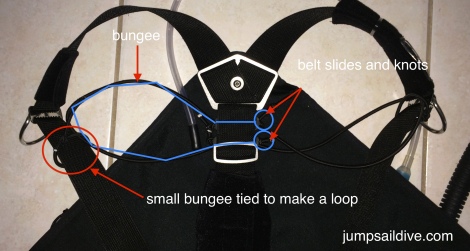Back in April 2013 I took PADI’s Tec Sidemount Speciality course on the Hollis SMS50. I then purchased a Razor2 harness and did my first dive on it in August 2014. Since then I have been trying to go diving in sidemount but the opportunities haven’t been there. The main reason is that I have been missing the kit to do it. A regulator hose that was too small, not having cambands, and not enough bolt snaps. The list could go on but it’s just too boring to repeat here. I could have saved myself a lot of hassle by purchasing ready made kits for sidemount but the reason I chose not to do this was because these kits are expensive and I couldn’t afford them at the time – so I bought them piece by piece. However I have over come these problems and know I have everything I need to dive sidemount (I even purchased my own cylinders).
Setting up a Razor is a complex task there are so many adjustments to make that it takes some time. I have heard that Steve Martin can get one set up in under 3 hours, that is an impressive feat and it is probably why he is such a good instructor. My Razor is almost setup. There are still a few tweaks that I have to do to it but I believe that it is almost done.
The Razor is meant to be used with a continuous bungee. This is useful as it keeps the cylinders in close and tight however, it does mean that if it was to fail then both cylinders would become detached and it would be an annoying situation to resolve. There is another option and that is to use the Armadill style looped bungees. This gives each cylinder its own bungee so that failure of both bungees is unlikely.
I have found one problem with it, the cylinder that is not attached to the harness by an inflater hose falls back under my armpit making it a little tricky to access. This doesn’t happen with the single continuous bungee. I have thought hard about this and there are a few solutions that I have come up with.
- Shorten the length of the bungee. I did this and it helped keep the cylinder closer to my body but it did not stop it from slipping back.
- Shorten the line that connects the bolt-snap to the camband. This should have the affect of keeping the cylinder forward, I have made the adjustments and plan to test this on my next dives.
- Move the camband further up the cylinder. Looking at photos of Steve Martin and his students it would seem to me that where I have my cambands could be too low. His students have the cambands or radiator straps at one third or three eights of the way up from the bottom of their cylinder. I was taught that the cambands should be close to the bottom of the cylinder with the bolt-snap just narrowly missing the ground. Though by moving the camband further up the cylinder I risk having the cylinders not horizontal when they are near empty.
If none of these options work then I may just have to resort to using the single continuous bungee. I am hoping to do a couple of dives this weekend. But it will depend on the weather as it is forecast 20kt winds.




Pingback: Why you should never get painted scuba tanks | Jump - Sail - Dive·